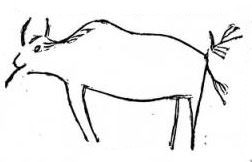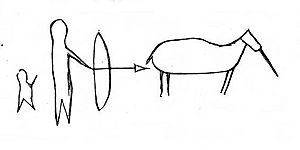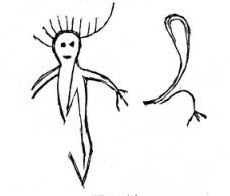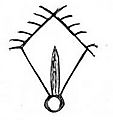Samuels' Cave facts for kids
Quick facts for kids |
|
|
Samuels' Cave
|
|
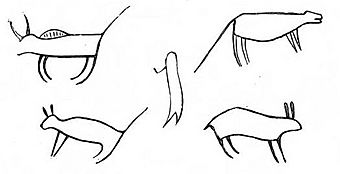
Some of Brown's tracings from the cave, not in their original arrangement
|
|
| Nearest city | Barre Mills, Wisconsin |
|---|---|
| NRHP reference No. | 86003275 |
| Added to NRHP | June 11, 1991 |
Samuels' Cave, also known as Brown's Cave or Mystery Cave, is a special place in La Crosse County, Wisconsin. It's a natural rock shelter, which is like a shallow cave or overhang in a cliff. Inside, you can find ancient drawings and carvings made by Native American people long ago. These amazing artworks are called petroglyphs (carvings) and pictographs (paintings). Samuels' Cave was added to the National Register of Historic Places in 1991 because it's so important.
Contents
How the Cave Was Found
This cool cave is about 30 feet deep. An 18-year-old named Frank Samuel found it in 1878. He was trapping raccoons when he squeezed into a small hole that an animal had dug. To his surprise, he popped out into a dark, hidden space!
On the cave walls, Frank saw simple pictures left by people from a very long time ago. That winter, some local boys used the cave as their secret hideout. They built fires and even carved their own names on the walls.
Exploring the Ancient Art
The next summer, a man named Rev. Edward Brown visited Samuels' Cave. He carefully traced the ancient carvings so they wouldn't be lost. He also convinced Frank's father to open up the cave's entrance more and protect the inside.
Brown told the State Geologist and the Wisconsin Historical Society about his discovery. They sent an archaeologist named John Rice to dig up the cave floor. They found four different layers of ash, separated by layers of clean sand. This showed that people had lived in the cave at least four different times, with long breaks in between.
What Archaeologists Found
In the second layer, they found pieces of pottery made from clay and ground-up shells. The third layer had even fancier pottery, clam shells, and a tool made from bone.
Modern archaeologists now know that pottery made with shell pieces was common for the Oneota people. This means that at least some of the cave art was likely made by them. The Oneota people lived in this area between the years 1300 and 1625 A.D.
What the Pictures Show
Some of the images on the cave walls were carved into the rock, while others were painted. Rev. Brown thought he saw animals like bison, lynx, rabbits, otters, badgers, elk, and herons.
One part of the wall showed a hunter and an elk. Another picture showed a hunter aiming a bow and arrow at a deer, with a child standing behind them. There was also a human figure wearing a headdress, which Brown believed was a chief. Other designs were harder to understand.
In 1984, archaeologists from the Mississippi Valley Archaeological Center at the University of Wisconsin-La Crosse visited the cave. They found charcoal drawings on the back wall that no one had noticed before!
Protecting the Cave
When Frank Samuel first found the cave in 1878, many of the images were in good shape. This was because a landslide had sealed the cave entrance for many years, protecting the art from weather changes.
But once the cave was reopened, moisture and temperature changes started to damage the sandstone. Over the years, many people visited the cave, and some even carved their own names over the ancient pictures. Because of all this, many of the prehistoric images have been badly damaged. To protect what's left, Samuels' Cave is no longer open to the public.
Images for kids


